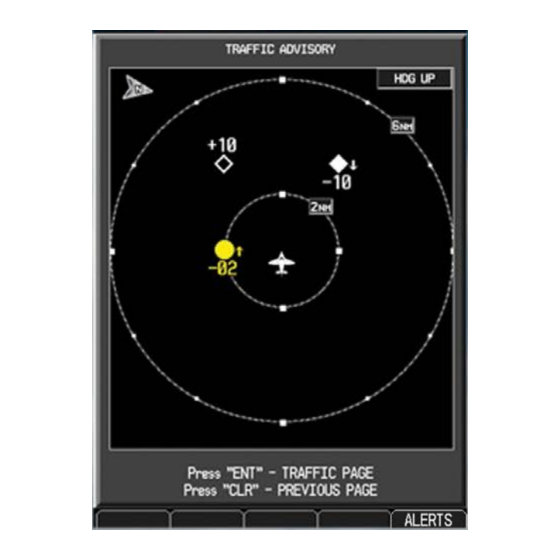
Table of Contents
Advertisement
Advertisement
Table of Contents

Summarization of Contents
General Theory of Operation
Active Surveillance
Explains how GTS systems track nearby aircraft via transponder interrogation, providing bearing, distance, and altitude.
ADS-B IN
Details the reception of traffic data via 1090 MHz Extended Squitter for enhanced situational awareness.
System Components
System Processor
Describes the central unit connecting antennas, displays, controls, and aircraft interfaces for the GTS system.
Antennas
Covers the use of directional and omni-directional antennas for transmitting interrogations and receiving replies.
External Amplifier
Details the GPA 65 module, a Power Amplifier and Low Noise Amplifier for specific GTS models.
System Interfaces
Altitude Source
Requires a pressure altitude source for calculating relative altitudes between aircraft.
Transponder Interface
Explains the need for a Mode S transponder interface for most GTS systems to manage traffic data.
Traffic Display
Describes the display of traffic information, including bearing, range, altitude, and vertical trend.
Audio System
Highlights the requirement for an audio system to provide aural alerts and system messages.
Landing Gear Position
Discusses how landing gear status can affect traffic advisory audio and sensitivity.
Radar Altimeter
Explains how radar altimeter data can be used to adjust alerts and filter ground traffic.
GPS
Covers GPS as an optional interface for ADS-B In, air/ground detection, and altitude calculations.
Magnetic Heading
Details how magnetic heading aids in turn correction and ADS-B In functionality.
Air/Ground Switch
Describes the air/ground switch for automatic mode switching and detection.
Control Switches
Explains the use of external switches for mode selection, self-test, and muting advisories.
System Operation
Operating Modes
Details system modes like Standby, Operate, and Self-test, and their functions.
Traffic Information
Explains how GTS systems provide fused traffic pictures with bearing, range, and altitude data.
ADS-B In Applications - SURF, AIRB
Describes the use of ADS-B In for Airborne and Surface Situational Awareness.
Traffic Alerting
Covers visual and aural alerts (TAs) for conflicting traffic based on range and closure rate.
Ownship Air/Ground Detection
Explains methods used to determine if the aircraft is on the ground or in the air.
Automatic Mode Switching
Details how the system switches between Operate and Standby based on air/ground status.
Calculated Height Above Ground
Describes how height above ground is calculated for aircraft without a radar altimeter.
Ground Traffic Filtering
Explains methods to reduce clutter by filtering out traffic on or near the ground.
Self-Test
Details the process for manually initiating a system self-test to verify functionality.
Q and A
What are the benefits of ADS-B?
Summarizes the additional information ADS-B provides for enhanced flight crew situational awareness.
When is ADS-B In available?
Explains the conditions for ADS-B In functionality being enabled and controlled by the crew.
How are active and ADS-B In targets displayed?
Directs users to display documentation for details on target display capabilities.
What capabilities does GPS data provide?
Lists GPS data uses like ADS-B In, air/ground detection, and altitude calculations.
What kind of transponder is required for use with the GTS Traffic System?
Specifies the requirement for a compatible Mode S transponder for most GTS systems.
Is ADS-B Out required with the GTS Traffic System?
Clarifies that ADS-B Out is not required for the ADS-B In feature.














Need help?
Do you have a question about the GTS 800 TAS and is the answer not in the manual?
Questions and answers